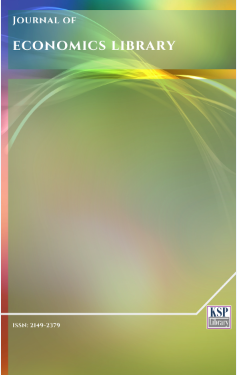Economic Progress as Related Sets of Non-Repeating Eclipses
Abstract
Abstract. I use a seemingly simple analogy of lunar and solar eclipses and set theoretical language to characterize how objects (factors) and ideas (forces) have determined the course of economic progress. In the early Ages economic progress depended heavily on objects, i.e., objects eclipsed ideas. From the end of Classical Antiquity to the present, objects, ideas, and their interactions and intra-actions have driven economic progress. The future of economic progress would depend principally on ideas, not because objects would vanish, but because object productivity would increasingly depend on ideas. While the welfare implications of the full idea eclipse of objects are difficult to pin down, they are not inconceivable. One obvious outcome is that different regions and countries will continue to perform differently because ideas will remain unevenly distributed, and even when they are evenly distributed, they will not be equally productive in all places. Such a policy implication recommends more investment in ideas than in objects in order to close the gaps in economic progress across regions and countries.
Keywords.Economic progress, Object-idea eclipse, Idea-object eclipse.
JEL. O10, O33, O47, N10.Keywords
References
Amavilah, V.H. (2014a). Sir W. Arthur Lewis and the Africans: Overlooked economic growth lessons. MPRA Paper No. 57126. [Retrieved from].
Amavilah, V.H. (2014b). Human knowledge and a commonsensical measure of human capital: A proposal. MPRA Paper No. 57670. [Retrieved from].
Amavilah, V.H. (2009). Knowledge of African countries: production and value of doctoral dissertations, Applied Economics, 41(7-9), 977-989. doi. 10.1080/00036840601019117
Amavilah, V.H. (2005). Resource intra-actions and interactions: Implications for technological change and economic growth. [Retrieved from].
Arrow, K.J. (1969). Classificatory notes on the production and transmission of technological knowledge, American Economic Review, 59(2), 244-250.
Benhabib, J., & Spiegel, M. (2002). Human capital and technology diffusion. FRBSF Working Paper No. 2003-02. [Retrieved from].
Benhabib, J., & Spiegel, M. (1994). The role of human capital in economic development: Evidence from aggregate cross country data. Journal of Monetary Economics, 34(2), 143-173. doi. 10.1016/0304-3932(94)90047-7
Bury, J.B. (1960[1932]). The Ideas of Progress: An Inquiry into Its Origin and Growth. New York: Dover Publications, Inc.
De Long, J.B. (1998). Estimates of world GDP, one million BC - present.” [Retrieved from].
Eicher, T. (1996). Interaction between endogenous human capital and technological change. Review of Economic Studies, 63, 127-144. doi. 10.2307/2298118
Elton, G.R. (1963). Renaissance and Reformation: 1300-148. New York: Macmillan Company.
Graca, J., Jafarey, S., & Philippopolous, A. (1995). Interaction of human capital and physical capital in a model of endogenous growth. Economics of Planning, 28(2-3), 93-118. doi. 10.1007/BF01263633
Grier, R. (2002). On the interaction of human and physical capital in Latin America,” Economic Development and Cultural Change, 50(4), 891-913. doi. 10.1086/344096
Grier, R. (2005). The interaction of human capital and physical capital accumulation: Evidence from Sub-Saharan Africa. Kyklos 58(2), 195-211.
Hayek, F.A. (1937). Economics and knowledge, Economica, 4(16), 386-405.
Hayek, F.A. (1945). The use of knowledge in society. American Economic Review, 35(4), 519-530.
Hayek, F.A. (1974) The pretense of knowledge” Nobel Prize Lecture. [Retrieved from].
Hicks, J.R. (1969). A Theory of Economic History. New York: Oxford University Press.
Lewis, W.A. (1965[1955]). The Theory of Economic Growth. New York: Harper Torchbooks.
Lucas, R.E., & Moll, B. (2014). Knowledge growth and the allocation of time. Journal of Political Economy, 122(1), 1-51. doi. 10.1086/674363
Marx, K., & Engles, F. (1967[1848]). The Communist Manifesto. New York: Penguin [Classics] Books.
Mincer, J. (1981). Human capital and economic growth. NBER Working Paper, doi. 10.3386/w0803
Mincer, J. (1958). Investment in human capital and personal income distribution. Journal of Political Economy, 66(4), 281-302. doi. 10.1086/258055
Nisbet, R. (1980). History of the Idea of Progress. New York: Basic Books, Inc., Publishers.
Parente, S., & Prescott, E. (1994). Barriers to technology adoption and development. Journal of Political Economy, 102(2), 298-321. doi. 10.1086/261933
Rima, I.H. (1978). Development of Economic Analysis, 3rd Edition. Homewood (IL): Richard D. Irwin, Inc.
Rodrik, D. (2013). The past, present, and future of economic growth. Global Citizen Foundation. [Retrieved from].
Romer, P.M. (1993). Idea gaps and object gaps in economic development. Journal of Monetary Economics, 32(3), 543-573. doi. 10.1016/0304-3932(93)90029-F
Roser, M. (2014). GDP Growth Over the Very Long Run. Published online at OurWorldInData.org. [Retrieved from]
Russell, B. (1948). Human Knowledge: Its Scope and Limits. New York: Simon and Schuster.
Russell, B. (1956). On propositions: what they are and how they mean, in Logic and Knowledge: Essays 1901-1950, RC Marsh (ed). New York: Capricorn Books.
Schumpeter, J.A. (1954). History of Economic Analysis. New York: Oxford University Press.
Sowell, T. (1996). Knowledge and Decisions. New York: Basic Books.
DOI: http://dx.doi.org/10.1453/jel.v3i2.825
Refbacks
- There are currently no refbacks.
.......................................................................................................................................................................................................................................................................................................................................
Journal of Economics Library - J. Econ. Lib. - JEL - www.kspjournals.org
ISSN: 2149-2379
Editor: [email protected] Secretarial: [email protected] Istanbul - Turkey.
Copyright © KSP Library

